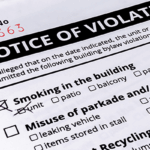
Common HOA Violations and How to Handle Them
October 13, 2025
Why Consistent Rule Enforcement is Essential for HOAs
October 24, 2025Disasters don’t give advance notice or wait for convenient timing. Tornadoes appear with barely enough time to take shelter. Floods rise while people sleep. Winter storms knock out power for days, leaving communities scrambling in the dark without heat or communication.
Most HOA boards assume that their insurance policy and a list of emergency contacts equals disaster preparedness. That assumption falls apart fast when actual disasters hit; real recovery requires detailed planning, established relationships, clear procedures, and systems that function when everything else breaks down.
Beyond Emergency Phone Numbers
Disaster recovery means more than keeping contractor phone numbers in a desk drawer. It covers how communities will respond when a crisis hits, communicate with panicked residents, coordinate repair crews, document damage for insurance, process claims, and get operations back to normal.
Different disasters need different responses. Severe weather demands different protocols than gas leaks. Fires require different procedures than flooding. What works for a tornado won’t help during a cyberattack on community systems. Plans addressing only one type of disaster leave communities vulnerable to all others.
Recovery planning must also account for residents with different needs. Some people need evacuation assistance. Others require temporary housing coordination. Disaster recovery plans that solely address property damage overlook critical human needs, especially those of elderly or disabled residents who may require additional assistance beyond what non-disabled neighbors can provide. This creates hazardous gaps in preparedness.
What Unpreparedness Actually Costs
Communities without plans pay steep prices when disasters strike. Board members make critical decisions based on panic rather than preparation. Residents overwhelm management with questions nobody can answer. Multiple board members contact different contractors without coordination, creating vendor confusion and duplicated efforts.
Insurance claims suffer badly without proper documentation. Adjusters demand specific evidence, detailed records, and clear damage timelines that unprepared communities can’t provide. Poor documentation can slash settlement amounts or delay reimbursement for months, while communities struggle to fund repairs.
Financial losses multiply beyond immediate damage. Communities without pre-negotiated vendor relationships pay inflated emergency rates. Contractors recognize desperate situations and charge accordingly, knowing communities will accept high prices when they need immediate repairs to prevent additional damage.
Delays create cascading problems. Power outages spoil frozen food in clubhouse kitchens. Minor water damage can become a major mold problem when leaks go unaddressed for days. When recovery drags on, problems multiply fast. Initial damage gets worse, and new issues pop up; broken security systems or empty properties become targets for thieves and vandals looking for easy opportunities.
Communication When Everything Breaks
Communication systems fail precisely when communities need them most. The Internet drops during power outages. Cell towers become overloaded. Email doesn’t reach residents without electricity. Backup communication methods only matter if they actually work during disasters when normal systems crash.
Keeping contact information current requires constant effort. Phone numbers change. Residents relocate. Email addresses get ditched for new ones. During actual emergencies when you desperately need to reach everyone, outdated contact lists leave you unable to communicate with huge chunks of your community.
Lists should include multiple contact methods per household, as well as out-of-area emergency contacts who can reach residents when local systems fail.
Clear authority chains prevent decision paralysis. Who makes emergency calls when the board president is unreachable? What can management authorize before getting board approval? Which situations demand immediate resident notification versus routine updates the next day?
Pre-written message templates save critical time during disasters. Draft notifications for common scenarios can be customized quickly when seconds matter. Templates should cover evacuation orders, utility disruptions, facility closures, security concerns, and updates on recovery progress.
Social media and text alerts reach residents even when email fails. Many people check these platforms constantly, even during power outages that prevent them from accessing their computers. It’s important that you get your official communication platforms running properly now and educate residents about where to find trustworthy information instead of the wild rumors that fly around during emergencies.
Vendor Relationships Before Crisis Hits
Emergency vendor relationships established during calm periods prove invaluable during chaos. Communities need pre-negotiated contracts with water extraction companies, emergency electricians, debris haulers, tree services, and temporary power providers.
Disasters overwhelm qualified contractors fast. Companies with existing relationships tend to prioritize their established clients when demand spikes. Communities without prior relationships wait days or weeks for service while damage worsens and costs multiply.
Pre-qualifying vendors during non-emergencies prevents costly mistakes. Communities can verify licenses, check insurance coverage, contact references, and thoroughly review capabilities. Emergency situations eliminate time for proper contractor vetting, leading to poor hiring decisions.
Agreements with nearby communities create backup options when things go wrong. If your regular contractors are swamped or unavailable, these partnerships let you tap into other communities’ vendor lists. Everyone wins because the arrangements work both ways.
Money Problems During Recovery
Reserve funds rarely cover major disasters adequately. Insurance helps, but deductibles are immediately applicable, coverage gaps emerge, and reimbursement can take months. Communities need access to emergency funds or established credit lines for disaster response costs.
Annual insurance reviews catch coverage problems before disasters expose them. Policies adequate five years ago may fall short after property improvements or construction cost increases. Reviews should specifically examine disaster-related exclusions, coverage limits, and policy gaps to ensure comprehensive coverage.
Assessment increases take time under normal procedures. Governing documents require notice periods, voting procedures, or other delays that complicate emergency funding. Communities should understand these requirements and consider emergency assessment provisions before disasters create urgent funding needs.
Disaster assistance programs and grants often become available after declared emergencies. Communities should research eligibility requirements and application procedures for federal, state, and local programs beforehand. Professional managers know how to deal with government red tape and bureaucratic application processes that confuse most volunteers.
Documenting Everything When You’re Under Stress
Good documentation makes the difference between getting your full insurance payout versus eating thousands in repair costs yourself. You need simple procedures that actually work when everything’s falling apart around you.
Taking photos before disasters happen establishes what you had originally. Keep current pictures of every common area, amenity, and piece of infrastructure. These baseline shots prove what existed before damage occurred, backing up your claims and shutting down insurance adjusters who might argue about original conditions.
Standard forms for recording damage keep everyone on the same page.
Pre-designed forms with specific fields for location, damage description, estimated costs, and safety hazards help multiple people document consistently. Generic note-taking creates incomplete records that hurt claims.
Separate accounting for disaster expenses simplifies reimbursement tracking. Dedicated accounts or cost codes allow clear separation of emergency spending from routine operations. Every disaster-related receipt and invoice must be saved for insurance and potential disaster assistance claims.
Communication logs document resident notifications, shared information, and responses received. Records proving adequate notice during evacuations or closures protect against later disputes about whether communities provided proper warnings.
Plans That Gather Dust Don’t Work
Disaster plans filed away don’t help during actual emergencies. Plans only work when board members, management staff, and key volunteers understand their roles and regularly practice procedures.
Annual training involves walking through scenarios with everyone assuming emergency responsibilities. Training should cover communication protocols, damage documentation, vendor coordination, and insurance procedures. Role-playing exercises expose planning gaps before real emergencies test them.
Tabletop exercises test plans without actual disasters. Facilitators present hypothetical scenarios while participants work through planned responses, revealing unclear procedures, coordination problems, and missing elements that can be fixed proactively.
Updates should be provided after every training session or test. Participants consistently identify outdated contacts, confusing procedures, or missing elements during exercises. Plans need regular revision based on lessons learned and changing circumstances.
Resident drills for specific scenarios build familiarity with procedures. Running through evacuation routes when nothing’s wrong, finding out where storm shelters are located, and figuring out how to shut off utilities before emergencies happen eliminates panic and confusion when real crises strike.
Legal Issues During Disasters
Governing documents may grant specific emergency powers or maintain strict limitations on board authority. Understanding what actions boards can take without normal approval processes prevents legal problems during time-sensitive situations.
Liability concerns arise during response and recovery. Board members making good-faith emergency decisions typically receive business judgment protection; however, documentation of the decision rationale provides additional safeguards. Building codes don’t get waived just because you’re doing emergency repairs. Some cities fast-track permits during disasters, but you still need proper approvals before starting work. Knowing local emergency permitting rules can prevent code violations when you’re rushing to repair damage.
Housing laws complicate the handling of displaced residents. Fair housing protections, accommodation requirements, and rental regulations all affect disaster response decisions. Have a lawyer review your recovery plan before disasters force you to make quick decisions under pressure.
Professional Management Makes Disasters Less Disastrous
Management companies bring disaster experience from multiple communities through various emergencies. They’ve seen what works, what fails, and which mistakes communities make repeatedly under pressure.
Established vendor networks provide immediate access to contractors during emergencies. Management relationships often secure faster responses than individual communities negotiating with overwhelmed vendors during crisis periods.
Insurance expertise maximizes reimbursement while minimizing delays. Professional managers understand documentation requirements, proper filing procedures, and negotiation strategies that protect community interests against adjusters trying to minimize payouts.
An around-the-clock emergency response ensures that someone knowledgeable is always available. Board members can’t maintain 24/7 availability, but professional management provides continuous coverage during extended disasters.
Start Planning Today
Disaster planning shouldn’t wait for approaching storms or imminent threats. Communities should plan during calm periods when thoughtful preparation is more effective than a rushed response to a crisis.
Begin with vulnerability assessment. Which disaster types pose the most significant risks? What facilities or systems would cause maximum disruption if damaged? Where do current preparedness efforts fall short?
Involve residents in planning. Community members often have emergency management, construction, insurance, or other relevant expertise. Resident participation also builds support for preparedness investments.
Make plans accessible. Recovery plans are ineffective if nobody can locate them during emergencies. Store digital copies in cloud locations accessible anywhere. Keep physical copies in multiple secure locations.
Review plans regularly. Annual updates ensure that plans reflect current conditions, updated contacts, and lessons learned from the experiences of other communities.
Protect What Matters
Disaster recovery planning invests in community resilience. While hoping disasters never strike, responsible boards prepare for worst-case scenarios while working toward best outcomes.
Communities with solid plans experience faster restoration, lower costs, better insurance results, and less resident disruption. Planning efforts deliver returns when disasters occur.
Professional management guides communities through planning processes, applying experience from numerous disasters to create practical plans that actually work under pressure.
Contact Neighborhood Management to learn how professional services can help develop recovery plans, establish vendor relationships, and prepare for any challenges that may emerge. Our team understands disaster planning and can help ensure your neighborhood responds effectively when emergencies strike.






